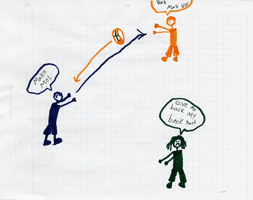| Home |
| For Teachers |
| For Parents |
| For Kids |
| Topics of Interest |
| Bullying Among Girls |
| Beyond the Bully-Victim Dyad |
| Resources |
| Contact Us |
Topics of Interest
Beyond the Bully-Victim Dyad
Untitled, Zack, age 9
Early studies on bullying focused on the behavior of the bully or the
victim, or the bully-victim dyad. Current approaches often adopt
an ecological perspective (e.g., Bronfenbrenner, 1977; Swearer & Doll,
2001), which also examines the broader context (and especially the many
interrelated systems of the environment) in which bullying occurs.
For example, ecological approaches to bullying have directed our attention
to how school playground design may influence types of play and levels
of aggression. Other theoretical perspectives--such as dynamic systems
theory and systems theory--have also extended the scope of study beyond
the bully-victim dyad (Pepler, Craig, & O'Connell, 1999). For
instance, recent studies have begun to examine the role that peers play
in sustaining or discouraging school bullying (e.g., Espelage & Holt,
2001), including the role of passive observers or bystanders (e.g., Jeffrey,
Miller, & Linn, 2001).
This section is devoted to discussions that extend our thinking about
bullying beyond the bully-victim dyad. We believe that in our various
roles (as peers, teachers, principals, parents, members of the school board,
members of the community, etc.), we may all play a part in a larger system
that either works to sustain, or to stop, school bullying. Get Off the Slide: Stopping Playground Bullying / Amanda Wagner
Beyond the Bully Victim Dyad: The Role of Peers in Bullying Relationships
/ Adrienne Manarina
References
Bronfenbrenner, U. (1977). Toward an experimental ecology of human development.
American
Psychologist, 32, 513-531.
Espelage, D. L., & Holt, M. K. (2001). Bullying and victimization
during early adolescence: Peer influences and psychosocial correlates.
In R. A. Geffner, M. Loring, & C. Young (Eds.), Bullying behavior:
Current issues, research and interventions, (pp. 123-142). New York:
Haworth.
Jeffrey, L. R., Miller, D., & Linn, M. (2001). Middle school bullying
as a context for the development of passive observers to the victimization
of others. In R. A. Geffner, M. Loring, & C. Young (Eds.), Bullying
behavior: Current issues, research and interventions, (pp. 143-156).
New York: Haworth.
Pepler, D., Craig, W. M., & O'Connell, P. (1999). Understanding
bullying from a dynamic systems perspective. In A. Slater & D. Muir
(Eds.), Developmental Psychology (pp. 440 - 451). London: Blackwell.
Swearer, S. M., & Doll, B. (2001). Bullying in schools: An ecological
framework. In R. A. Geffner, M. Loring, & C. Young (Eds.), Bullying
behavior: Current issues, research and interventions, (pp. 7-23). New
York: Haworth.
(Word
Version, PDF
Version)
(Word
Version, PDF
Version)